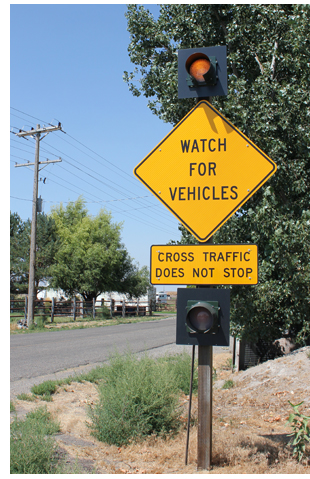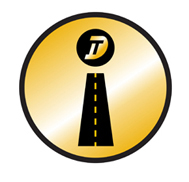

Intersection warning system enhances safety
for rural drivers
Rural highway intersections can be hazardous if drivers are not aware of upcoming stops and free-flowing traffic crossing their paths. District 4 recently incorporated a lower-cost system to help save lives.
The intersection of Idaho Highway 25 and Baseline Road east of Rupert has been the site of many crashes caused by blow-through traffic or drivers that erroneously pull in front of oncoming traffic. Several crashes and fatalities have resulted over the decades. What makes many rural intersections tricky to navigate is that traffic in one direction is required to stop and gauge oncoming, free-flowing traffic, which may be obscured by crops and overgrown weeds. 
Because of these issues, the intersection was identified in a safety study as a likely candidate for improvements. Since the initial recommendation would have exceeded budget and time constraints, several considerations were made before a Rural Intersection Conflict Warning System (RICWS) was decided upon, said ITD District 4 Traffic Engineer Bruce Christensen.
The RICWS system, which has been used in other states but was new to ITD, incorporates dynamic flashing beacons to alert stopping drivers when high-speed traffic is approaching.
“We took what has been used in other states and using it here to solve a major problem,” Christensen said. “The original plan was to put in a beacon on all four approaches, but as we got into the design further, we ended up with just one approach, since that is where the blow-throughs happen.”
The beacon flashes toward northbound traffic to alert when east-west traffic is approaching,
The design, which was borrowing greatly from the Minnesota DOT, incorporated another innovation to provide vehicle detection — bored tubes featuring micro-loop sensors.
The tubes were used instead of detection loops cut into the pavement, which get in the way of future maintenance work. They are placed in the road base and can pick up crossing vehicles with great accuracy.
Other improvements were the addition of rumble strips in the northbound lane, alterations to the flash times and detection zones, and wording on warning signs.
“Our concern was people getting used to the flashers when stopping and knowing to trust it,” Christensen said.
The innovation is improving safety well enough that Christensen is considering similar applications at other highway intersections in the district.
Published 08-25-17